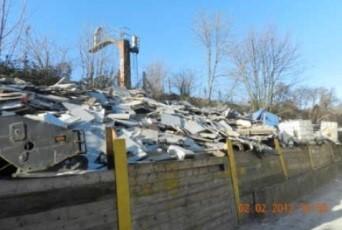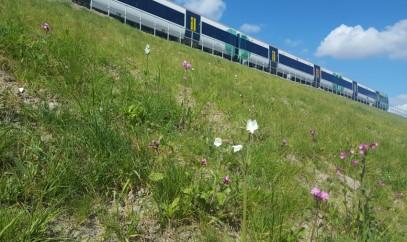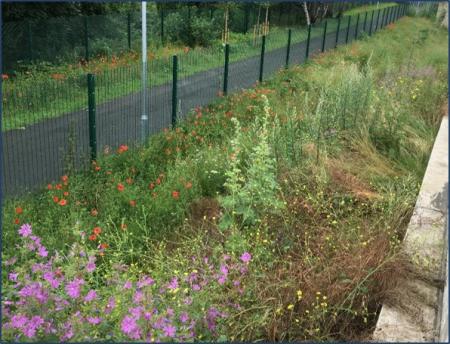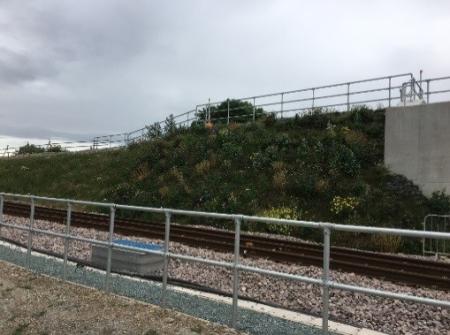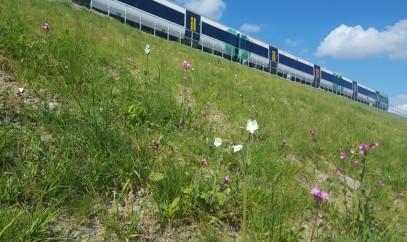
Area characterisation:
The site is located to the east of London Bridge station in a highly urbanised area close to South Bermondsey train station and Millwall football stadium, surrounded by commercial and residential properties.
Objective:
To untangle the tracks approaching London Bridge station reducing delays and to achieve net positive biodiversity.
Images
Financing:
The total cost was £50 million and was funded by Network Rail as part of the Thameslink Programme.
Potential impacts/benefits:
|
|
Potential impacts/ benefits |
|||
|
Challenges addressed |
Enhancing sustainable urbanisation |
Restoring ecosystems and their functions |
Developing climate change mitigation |
Developing climate change adaptation |
|
Green space management (Including enhancing/conserving urban biodiversity) |
· Changing image of the urban environment · Increase willingness to invest in NbS |
· Increase biodiversity · Increase quality and quantity of green infrastructures |
· Reduction of energy in the production of new buildings and building materials |
· Reduce run off |
|
Participatory planning and governance |
· Social learning about location and importance of NbS · Social inclusion |
|
|
|
Actions:
This project was delivered by Skansa and Network Rail as part of the Thameslink Programme which is committing to increasing the biodiversity of its sites, through a Biodiversity Net Positive Policy. The original Bermondsey site had limited botanical diversity and low conservation value and part of the site was previously owned by a waste supplier. The soil was contaminated with asbestos, Japanese Knotweed and hydrocarbons and the vegetation was fragmented meaning it was a poor habitat corridor.
The project involved the removal of 21,900 tonnes of contaminated material and the eradication of Japanese knotweed. To build the dive under, the existing viaduct arches were demolished and a separation junction was built for the Thameslink lines approaching London to ease congestion on the track. To improve the biodiversity of site, embankments were constructed either side of the railway on which wildflowers were planted, creating corridors and stepping stones to the wider area. The wildflower mix was chosen for its native species, low maintenance and attractiveness to pollinators. A further 765m squared of green walls were planted under arches and on access ramps. The project achieved an overall biodiversity net positive increase of 113%.
Network Rail worked with Lewisham and Southwark local authority to support their local Biodiversity Action Plan and engaged with the local community holding information sessions and site visits. An Operation and Maintenance Manual was produced for the maintenance team to help the habitat mature and become ecologically valuable.
Transferability of result:
Creation of biodiverse corridors can be designed into most new railway lines.
Lessons learnt:
It is important to plant at the right time to ensure success of wildflowers and prevent the infestation of pioneer species like Buddleia.
It is important to engage with local councils and communities to create the best design for the area.
Organisations:
Skansa
Network Rail
Ramboll
Client:
Network Rail
Design team:
Skansa
Network Rail
Ramboll
Contacts:
info@wenp.org.uk
Awards:
ICE London - Infrastructure award, 2017.
CEEQUAL ‘Excellent’ Whole Team Award of 96.6%.
Ground Engineering - Sustainability award 2017.
Finalists for Ciria’s Big Biodiversity Challenge
NBS goals:
- Restoring ecosystems and their functions
- Urban regeneration through nature-based solutions
NBS benefits:
- Reduce run-off
- Reduction of energy in the production of new buildings and building materials
- Increase Biodiversity
- Increase quality and quantity of green and blue infrastructures
- Changing image of the urban environment
- Increase willingness to invest in NBS
- Social inclusion
- Social learning about location & importance of NBS
